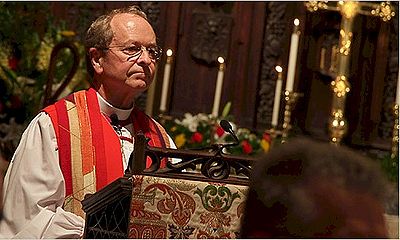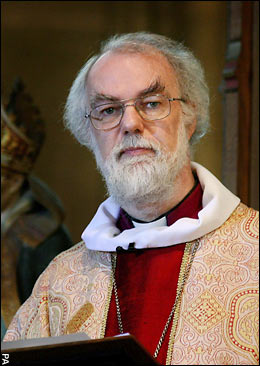Homosexuality and the Episcopalian Church
This entry is part of: LGBT Identities, Communities, and Resistance in North Carolina, 1945-2012
Ever since the 1970’s the Episcopalian church has been making moves to turn itself into an accepting and inclusive place for its LGBT members. Its boldest action was the election and ordination of Bishop Gene Robinson, the first openly gay bishop appointed in 2003. The church’s decisions in regards to homosexuals in the faith have been met with backlash from other religious groups and instigated a schism within the Episcopalian faith.
Homosexuality in the Acts of Convention
The Acts of Convection of the Episcopal Church is a digital record of decisions made by the national Episcopal Church from 1976-2009.
Study and Support
In 1976 the House of Bishops recognized the equal claim of homosexual people stating that, “it is the sense of this General Convention that homosexual persons are children of God who have a full and equal claim with all other persons upon the love, acceptance, and pastoral concern and care of the Church.”[1] In response to this, in 1979 66th General Convention of the Episcopal Church, meeting in Denver, expressed gratitude for the work of all groups which are ministering among homosexual persons in our society.[2]
Also in 1976 the convention decreed the importance of the study human sexuality, making it a priority of the church. In 1985, the House of Bishops resolved to “urge each diocese of this Church to establish a pastoral concerns committee on homosexuality to foster a better understanding of homosexual persons, to dispel myths and prejudices about homosexuality, to provide pastoral support, and to give life to the claim of homosexual.”[3]
Ordination and Activism
In its first act of activism the convention stated in 1976 that “homosexual persons are entitled to equal protection of the laws with all other citizens, and calls upon our society to see that such protection is provided in actuality.” "[4]
In 1988 the Episcopal convention focused itself on more specific issues. It concerned itself with the issue of suicide among gay and lesbian youth pledging to provide pastoral support of this troubled youth and to include the gay and lesbian data in their present resources on suicide for distribution to dioceses and congregations throughout the Church.[5] That same year they called for AIDS education programs in each congregation by the end of 1989. These programs would promote safe sexual practices.[6] This same convention addressed the increase of violence against homosexual persons called upon law enforcement officials to “prosecute guilty persons to the fullest extent of the law.” [7]
In 2000 the convention took up the issue of discrimination based on sexual orientation in the Boy Scouts of America. They decided to encourage the Boy Scouts of America to allow membership to youth and adult leaders irrespective of their sexual orientation, and “strongly encourage individual churches which charter or host scout units to open a dialogue with the unit leaders, scouts, and their parents regarding discrimination against youth and leaders on the basis of sexual orientation."[8]
In 2003 the convention, after much deliberation, allowed the ordination of Bishop Gene Robinson.[9]
Schism within the church
Anglican realignment
The ordination of Bishop Robinson served as a tipping point for separation within the church but internal disagreement already existed before that. In 1998 a group of Bishops in the Anglican Communion resolved that homosexual relations are "incompatible with Scripture" and advised the Episcopal Church against the blessing same-sex unions and the ordaining noncelibate homosexuals.[10]
In 2003, soon after the election of Bishop Robinson a group of conservatives gathered for a protest meeting in Dallas. The present group of clergy, bishops, and members of the church said that the Episcopal Church's General Convention had "broken fellowship with the larger body of Christ".[11]
The Anglican Communion Network and the Anglican Mission in the Americas
The Diocese of Pittsburgh is home to the Anglican Communion Network, which represents 10 conservative U.S. dioceses and more than 900 parishes within the Episcopal Church that are deciding whether to split from the denomination.[12]
An already divided group is the Anglican Mission of the Americas. This group existed before the ordination of Robinson, but after his election it became a place where those who’d come to disagree with the changes in the Episcopal found a new group. Currently the mission consists of 142 churches and is still growing. [13]
The Anglican Mission in the America s is also the founder of the Anglican Church in North America, a denomination of the Anglican faith that resulted in direct opposition of the Episcopal changes in terms of homosexuality. The church reports that it has 716 congregations and 287 ministry partner congregations serving more than 100,000 Christians in North America.[14]
The Anglican Communion
The Anglican Church in North America isn't a member of the international Anglican Communion, but that doesn’t mean that the international Anglican Church supports the decisions of the Episcopalian church. In 2006 Â Rowan Williams, the Anglican Archbishop of Canterbury and the head of the Worldwide Anglican Communion, said that homosexual activity is contrary to the teachings of Christianity and that homosexuals must change their behavior if they are to be welcome in the Anglican Church. He criticizes the Episcopal Church and the break it has caused in the Anglican tradition he says that The Worldwide Anglican Communion has been in a state of disintegration since the action in 2003 of the US Episcopal Church in ordaining as a bishop an active and unrepentant homosexual, Gene Robinson.[15]
References
- ↑ http://www.episcopalarchives.org/cgi-bin/acts/acts_resolution-complete.pl?resolution=1976-A069
- ↑ http://www.episcopalarchives.org/cgi-bin/acts/acts_resolution.pl?resolution=1979-C035
- ↑ http://www.episcopalarchives.org/cgi-bin/acts/acts_resolution-complete.pl?resolution=1976-D058
- ↑ http://www.episcopalarchives.org/cgi-bin/acts/acts_resolution-complete.pl?resolution=1976-A071
- ↑ http://www.episcopalarchives.org/cgi-bin/acts/acts_resolution-complete.pl?resolution=1988-D132
- ↑ http://www.episcopalarchives.org/cgi-bin/acts/acts_resolution-complete.pl?resolution=1988-D104
- ↑ http://www.episcopalarchives.org/cgi-bin/acts/acts_resolution-complete.pl?resolution=1988-A085
- ↑ http://www.episcopalarchives.org/cgi-bin/acts/acts_resolution-complete.pl?resolution=2000-C031
- ↑ http://www.episcopalarchives.org/cgi-bin/acts/acts_resolution-complete.pl?resolution=2003-C045
- ↑ Tu, Janet I. "A Church Torn in Two." The Seattle Times. The Seattle Times, 19 Feb. 2007. Web. 14 Apr. 2012. http://seattletimes.nwsource.com/html/faithvalues/2003578841_stephens19m.html
- ↑ "Conservatives Warn of Church Split." BBC News. BBC, 10 Sept. 2003. Web. http://news.bbc.co.uk/2/hi/americas/3171934.stm These kinds of sentiments began the large scale divide.
- ↑ Three Episcopal Dioceses Reject Presiding Bishop's Authority." Washington Post. The Washington Post, 29 June 2006. Web. http://www.washingtonpost.com/wp-dyn/content/article/2006/06/28/AR2006062802236.html?nav=rss_nation
- ↑ http://www.theamia.org/connect/find-a-church/
- ↑ http://www.anglicanchurch.net/?/main/page/about-acna
- ↑ "Anglican Archbishop of Canterbury Says Homosexual Sex Incompatible with Bible." LifeSiteNews.com. 28 Aug. 2006. Web. http://www.lifesitenews.com/news/archive/ldn/2006/aug/06082808
written by: Stephanie Nieves-Rios

